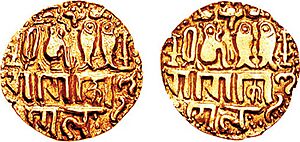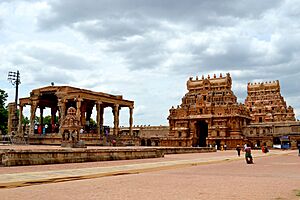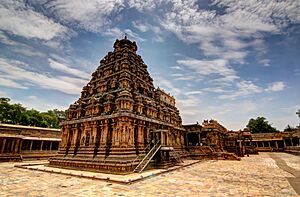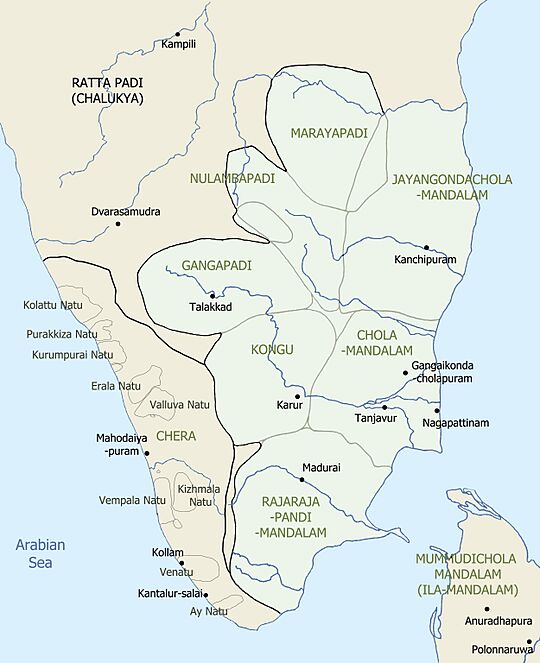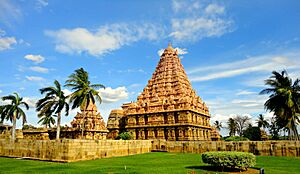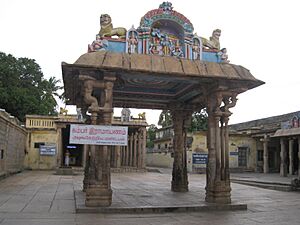Chola Empire facts for kids
Quick facts for kids
Chola Empire
|
|||||||||||||||||||||||||||||||||||||||
|---|---|---|---|---|---|---|---|---|---|---|---|---|---|---|---|---|---|---|---|---|---|---|---|---|---|---|---|---|---|---|---|---|---|---|---|---|---|---|---|
| 848–1279 | |||||||||||||||||||||||||||||||||||||||
|
Gold Gadyana coin of emperor Rajaraja I (985–1014). Uncertain Tamil Nadu mint. Legend "Chola, conqueror of the Gangas" in Tamil, seated tiger with two fish.
|
|||||||||||||||||||||||||||||||||||||||

The Chola Empire at its greatest extent c. 1030, under Rajendra I
|
|||||||||||||||||||||||||||||||||||||||
| Capital | Pazhaiyaarai, Thanjavur, Gangaikonda Cholapuram | ||||||||||||||||||||||||||||||||||||||
| Official languages |
|
||||||||||||||||||||||||||||||||||||||
| Religion | Hinduism | ||||||||||||||||||||||||||||||||||||||
| Government | Monarchy | ||||||||||||||||||||||||||||||||||||||
| Emperor | |||||||||||||||||||||||||||||||||||||||
|
• 848–871
|
Vijayalaya Chola (first) | ||||||||||||||||||||||||||||||||||||||
|
• 1246-1279
|
Rajendra III (last) | ||||||||||||||||||||||||||||||||||||||
| Historical era | Middle Ages | ||||||||||||||||||||||||||||||||||||||
|
• Established
|
848 | ||||||||||||||||||||||||||||||||||||||
|
• Empire at its greatest extent
|
1030 | ||||||||||||||||||||||||||||||||||||||
|
• Disestablished
|
1279 | ||||||||||||||||||||||||||||||||||||||
|
|||||||||||||||||||||||||||||||||||||||
The Chola Empire was a powerful kingdom in southern India during the Middle Ages. It was ruled by the Chola dynasty. This empire was known for its strong navy and its influence across Southeast Asia.
At its peak, the Chola Empire was a major player in South, Southeast, and East Asia. They sent ships to the Ganges River in northern India and even launched naval attacks on the Srivijaya Empire in Sumatra. The Chola navy was one of the strongest in ancient India.
The Cholas had a well-organized government and a skilled team of officials. They loved Tamil literature and built many beautiful temples. These temples were not just places of worship; they were also important centers for business. The Cholas were also famous for their art, especially their bronze statues of Hindu gods made using a special "lost wax" method. Their art and building styles even spread to Southeast Asia.
Contents
History of the Chola Empire
How the Chola Empire Began
The Chola Empire was started again by a ruler named Vijayalaya Chola in 848 CE. He took advantage of a fight between the Pandya and Pallava empires. Vijayalaya captured the city of Thanjavur and made it the capital of the new Chola Empire.
Later, under Aditya I, the Cholas grew stronger. They defeated the Pandyan dynasty and expanded their lands. Aditya I's son, Parantaka I, even conquered Sri Lanka (then called Ilangai) in 925 CE. However, the Cholas faced a setback when they lost a major battle to the Rashtrakutas.
The Cholas regained their strength under Parantaka II. His son, Aditha Karikalan, helped expand the kingdom. After a few more rulers, Rajaraja Chola I became emperor. He is known as one of the greatest Chola kings.
The Chola Empire's Golden Age
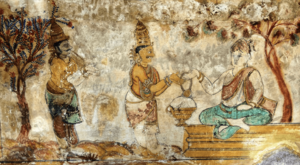
The Chola Empire reached its greatest size and power under Rajaraja I and his son, Rajendra Chola I. Their empire stretched from Sri Lanka in the south to the Godavari-Krishna river basin in the north. It also included the Malabar Coast, Lakshadweep, and the Maldives.
Rajaraja I was a very active ruler. He improved the government and strengthened local self-rule. In 1000 CE, he ordered a land survey to manage the empire's resources better. He also built the famous Brihadeeswarar Temple in Thanjavur in 1010 CE.
Rajendra I continued his father's work. His armies marched north, reaching the Ganges River in northern India. To celebrate these victories, Rajendra built a new capital city called Gangaikonda Cholapuram. He also successfully invaded the Srivijaya kingdom in Southeast Asia, which helped protect trade routes. Rajendra I sent diplomatic missions to China, showing the Cholas' global reach.
Conflicts with the Chalukyas
The Cholas often fought with the Western Chalukyas. These two empires were rivals for control over certain regions. The border between their kingdoms was usually the Tungabhadra River.
Chola kings like Rajadhiraja Chola I and Rajendra Chola II led many battles against the Chalukyas. Even though there were many fights, the Cholas usually kept control over the important Vengi region.
After a period of strong rule, the Chola dynasty faced a challenge when Athirajendra Chola died in 1070 without a direct heir. This led to a new period in Chola history.
The Later Chola Period

After Athirajendra Chola, Kulottunga I became the new emperor. He was the son of a Chola princess and an Eastern Chalukya prince. This marked the beginning of the "Later Chola" dynasty.
The Later Cholas, including Kulothunga I, Vikrama Chola, and Kulothunga III, were still strong rulers. They conquered new lands and kept the empire stable for a long time. However, around 1118, the Cholas started losing some control over regions like Vengi and Gangavadi.
By the early 1200s, the Chola Empire began to weaken. The Pandyan dynasty in South India grew more powerful. The Cholas also lost control of Sri Lanka.
The Empire Shrinks and Falls
Under later kings like Rajaraja Chola III and Rajendra Chola III, the Chola Empire faced many challenges. The Hoysalas, another powerful kingdom, often got involved in the politics of the Tamil region, sometimes helping the Cholas, sometimes not.
The Pandyas continued to gain strength. They gradually took over more and more Chola territory. By 1279, the Pandyan Empire had become the dominant power in South India. The last Chola emperor, Rajendra III, was defeated by the Pandyas. With this defeat, the great Chola Empire came to an end.
How the Chola Empire was Run
Chola Government and Rule
For the first time, much of South India was united under one government during the Chola rule. The Cholas had a monarchy, meaning a king ruled. The king was the supreme leader, making decisions and giving orders.
Chola kings built many temples and gave them great wealth. These temples were not just for worship; they were also important centers for business and community life. The empire was divided into provinces called mandalams, which were further split into smaller units.
Over time, the Chola kings gained more direct control over their lands. They replaced local lords with their own officials. This helped improve the administration and made the empire more organized. The government had a large department to manage land taxes. Villages also had their own self-governing groups.
Justice was mostly handled locally in villages. Small disputes were settled there. More serious crimes, like treason, were handled by the king. Punishments for minor crimes often involved fines or donations to charity.
The Chola Military
The Chola military was made up of four main parts: cavalry (soldiers on horses), elephant corps (soldiers on elephants), infantry (foot soldiers), and a navy. The emperor was the top commander.
The army had skilled bowmen and swordsmen. Chola soldiers were stationed in military camps across the country. Elephants were very important in battle, carrying soldiers who shot arrows or fought with spears. Many Chola soldiers were called Kaikolars, who were strong and received regular pay.
The Cholas built strong forts to protect their cities. These forts used bricks, stone, wood, and mud. Ancient texts describe how they defended forts with catapults, boiling water, and traps. Chola soldiers used swords, bows, spears, and steel shields. They even used a special type of steel called Wootz steel for their weapons.
The Chola navy was the strongest in ancient India. It was key to the empire's expansion, helping them conquer Sri Lanka and launch attacks on Srivijaya. The navy grew very powerful between 900 and 1100 CE.
Chola Economy and Trade
Land taxes and trade taxes were the main sources of money for the Chola Empire. The Cholas also made their own gold, silver, and copper coins. The economy had different levels: local farms, market towns (nagaram), and elite merchant groups who handled international trade.
Cotton cloth was a major export for the Cholas. The city of Uraiyur was famous for its cotton textiles. Weavers were important and often formed guilds. Silk weaving also became very skilled, with Kanchipuram becoming a major silk center.
Metal crafts, especially bronze sculptures, were highly developed. Wootz steel was another important Chola export. Farmers, especially the Vellalar community, were highly respected and economically powerful. They owned much of the land.
The Cholas also focused on irrigation. They built large stone dams across rivers like the Kaveri and dug canals to bring water to farms. Rajendra Chola I even built a huge artificial lake near his capital.
Merchants organized themselves into powerful guilds, like the Manigramam and Ayyavole. These guilds traveled to other countries for trade and sometimes even had their own armies to protect their goods.
Chola Hospitals and Healthcare

The Chola kings supported hospitals by giving them land for their upkeep. An old inscription from Tirumukkudal mentions a hospital named after King Virarajendra. Doctors at these hospitals cured many diseases. They had a chief physician, nurses, barbers (who did minor operations), and water carriers.
One Chola queen, Kundavai, also built a hospital in Thanjavur and provided land for its ongoing support.
Chola Society and Education
During the Chola period, many different groups and castes existed. Guilds were very important, especially for merchants. The Vellalar caste was a powerful group of landowners and often served in the government and army. The Kaikolar community were weavers and merchants who also had military roles.
Education was not widespread for everyone, but some village councils ran schools to teach basic reading and writing. Skills were often passed down from father to son. Monasteries were also centers of learning and received government support.
The Chola kings were known for their fair justice system. Priests often reminded kings that justice would bring them a good future, while injustice would lead to punishment.
Chola Foreign Trade
The Cholas were very active in foreign trade, reaching out to China and Southeast Asia. By the late 800s, South India had a lot of sea trade. Chola merchant guilds played a big role in trade between different regions and overseas.
China's Tang dynasty, the Srivijaya Empire, and the Abbasid Caliphate in Baghdad were major trading partners. The Cholas helped connect Chinese markets to the rest of the world. They even sent trading groups to China. For example, a Chola group visited the Chinese court in 1077, bringing back copper coins in exchange for goods like glass and spices.
Chola Art and Architecture
Magnificent Chola Temples
The Cholas continued the temple-building styles of earlier dynasties and added their own unique touch to Dravidian temple design. They built many beautiful Shiva temples along the Kaveri River. Chola temples are known for their grand size and detailed artwork. One historian said Chola artists "conceived like giants and finished like jewelers."
A new feature in Chola architecture was the huge gateway called a gopuram, which became common in later South Indian temples. Chola art and building styles spread to Southeast Asia and influenced their architecture.
The temples at Thanjavur and Gangaikondacholapuram show how grand Chola architecture became. The Brihadisvara Temple in Thanjavur, finished around 1009, was the largest and tallest Indian temple of its time. The temple at Gangaikondacholapuram, built by Rajendra Chola around 1030, was meant to be even grander. These two temples, along with the Airavatesvara Temple at Darasuram, are recognized as World Heritage Sites by UNESCO.
The Chola period is also famous for its sculptures and bronze statues. Many museums around the world have Chola bronzes of Hindu gods like Shiva and Vishnu. These statues are known for their classic beauty and grace. The famous Nataraja (Shiva as the Divine Dancer) statues are a great example of this art.
Chola Literature
Literature thrived during the Chola Empire. The famous poet Kambar lived during the reign of Kulothunga Chola III. His epic poem Ramavataram (also called Kambaramayanam) is a classic of Tamil literature. It's not just a translation of the Sanskrit Ramayana; Kambar added his own descriptions of Chola country.
Another important poet was Jayamkondar, who wrote Kalingattuparani. This poem describes Kulothunga's war in Kalinga, showing the excitement and harshness of battle. The poet Ottakuttan also wrote poems praising Chola kings.
Nannul, a Chola-era book on Tamil grammar, is still considered an important guide for literary Tamil. Telugu literature also developed under the patronage of Telugu Choda rulers, with poets like Tikkana writing important works.
In terms of religious writings, the Shaivite holy texts were organized into eleven books by Nambi Andar Nambi around the late 900s.
Chola Religion
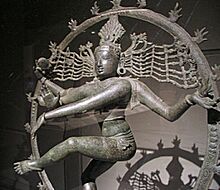
Generally, the Cholas followed Hinduism. While they built their largest temples for Shiva, they also supported other Hindu gods like Vishnu. For example, the second Chola king, Aditya I, built temples for both Shiva and Vishnu.
Rajaraja Chola I also supported Buddhists. He helped build a Buddhist monastery in Nagapattinam at the request of the Srivijaya king.
During the Later Chola period, there were some disagreements between different Hindu groups, especially between followers of Shiva (Shaivites) and followers of Vishnu (Vaishnavites). However, Chola kings never said that only Shaivism was the official religion of their empire. They often held titles like Sivapadasekharan, meaning "one who has Shiva's feet as his crown," but their inscriptions do not state that their clan only followed Shaivism.
Family Tree
| Medieval Cholas | |||||||||||||||||||||||||||||||||||||||||||||||||||||||||||||||||||||||||||||||||||||||||||||||||||||||||||||||||||||||||||||||||||||||||||||||||||||||||||||||||||||||||||||||||||||||||||||||||||||||||||||||||||||||||||||||||||||||||||||||||||||||||||||||||||||||||||||||||||||||||||||||||||||||||||||||||||||||||||||||||||||||||||||||||||||||||||||||||||||||||||||||||||||||||||||||||||||||||||||||||||||||||||||||||||||||||||||||||||||||||||||||
|---|---|---|---|---|---|---|---|---|---|---|---|---|---|---|---|---|---|---|---|---|---|---|---|---|---|---|---|---|---|---|---|---|---|---|---|---|---|---|---|---|---|---|---|---|---|---|---|---|---|---|---|---|---|---|---|---|---|---|---|---|---|---|---|---|---|---|---|---|---|---|---|---|---|---|---|---|---|---|---|---|---|---|---|---|---|---|---|---|---|---|---|---|---|---|---|---|---|---|---|---|---|---|---|---|---|---|---|---|---|---|---|---|---|---|---|---|---|---|---|---|---|---|---|---|---|---|---|---|---|---|---|---|---|---|---|---|---|---|---|---|---|---|---|---|---|---|---|---|---|---|---|---|---|---|---|---|---|---|---|---|---|---|---|---|---|---|---|---|---|---|---|---|---|---|---|---|---|---|---|---|---|---|---|---|---|---|---|---|---|---|---|---|---|---|---|---|---|---|---|---|---|---|---|---|---|---|---|---|---|---|---|---|---|---|---|---|---|---|---|---|---|---|---|---|---|---|---|---|---|---|---|---|---|---|---|---|---|---|---|---|---|---|---|---|---|---|---|---|---|---|---|---|---|---|---|---|---|---|---|---|---|---|---|---|---|---|---|---|---|---|---|---|---|---|---|---|---|---|---|---|---|---|---|---|---|---|---|---|---|---|---|---|---|---|---|---|---|---|---|---|---|---|---|---|---|---|---|---|---|---|---|---|---|---|---|---|---|---|---|---|---|---|---|---|---|---|---|---|---|---|---|---|---|---|---|---|---|---|---|---|---|---|---|---|---|---|---|---|---|---|---|---|---|---|---|---|---|---|---|---|---|---|---|---|---|---|---|---|---|---|---|---|---|---|---|---|---|---|---|---|---|---|---|---|---|---|---|---|---|---|---|---|---|---|---|---|---|---|---|---|---|---|---|---|---|---|---|---|---|---|---|---|---|---|---|---|---|---|---|---|---|---|---|---|---|---|---|---|---|---|---|---|---|---|---|---|---|---|---|---|---|---|---|---|---|---|---|
|
|||||||||||||||||||||||||||||||||||||||||||||||||||||||||||||||||||||||||||||||||||||||||||||||||||||||||||||||||||||||||||||||||||||||||||||||||||||||||||||||||||||||||||||||||||||||||||||||||||||||||||||||||||||||||||||||||||||||||||||||||||||||||||||||||||||||||||||||||||||||||||||||||||||||||||||||||||||||||||||||||||||||||||||||||||||||||||||||||||||||||||||||||||||||||||||||||||||||||||||||||||||||||||||||||||||||||||||||||||||||||||||||
Emperors
| Ruler | Reign | Notes | |
|---|---|---|---|
| Vijayalaya Chola | 848–870 | Founder of the Chola empire and descendant of the Early Cholas. | |
| Aditya I | 870–907 | ||
| Parantaka I | 907–955 | ||
| Gandaraditya | 955–957 | Ruled jointly. | |
| Arinjaya | 956–957 | ||
| Parantaka II | 957–970 | ||
| Uttama | 970–985 | ||
| Rajaraja I the Great | 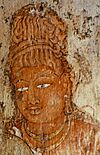 |
985–1014 | |
| Rajendra I |  |
1014–1044 | |
| Rajadhiraja I |  |
1044–1054 | |
| Rajendra II | 1054–1063 | ||
| Virarajendra | 1063–1070 | ||
| Athirajendra | 1070 | Left no heirs. | |
| Kulothunga I |  |
1070–1122 | Son of Amangai Devi Chola, daughter of Rajendra I, and Rajaraja Narendra, ruler of Eastern Chalukya dynasty. Kolothunga's reign started the period which was known as Chalukya-Chola dynasty or simply Later Cholas. |
| Vikrama | 1122–1135 | ||
| Kulothunga II | 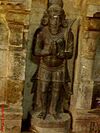 |
1135–1150 | Grandson of the previous. |
| Rajaraja II | 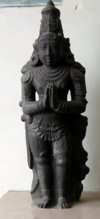 |
1150–1173 | |
| Rajadhiraja II | 1173–1178 | Grandson of king Virarajendra Chola. | |
| Kulothunga III | 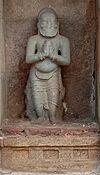 |
1178–1218 | |
| Rajaraja III | 1218–1256 | ||
| Rajendra III | 1256–1279 | Last Chola ruler, defeated by the Maravarman Kulasekara Pandyan I of the Pandya dynasty. After the war, the remaining Chola royal bloods were reduced to the state of being chieftains by the Pandyan forces. | |


